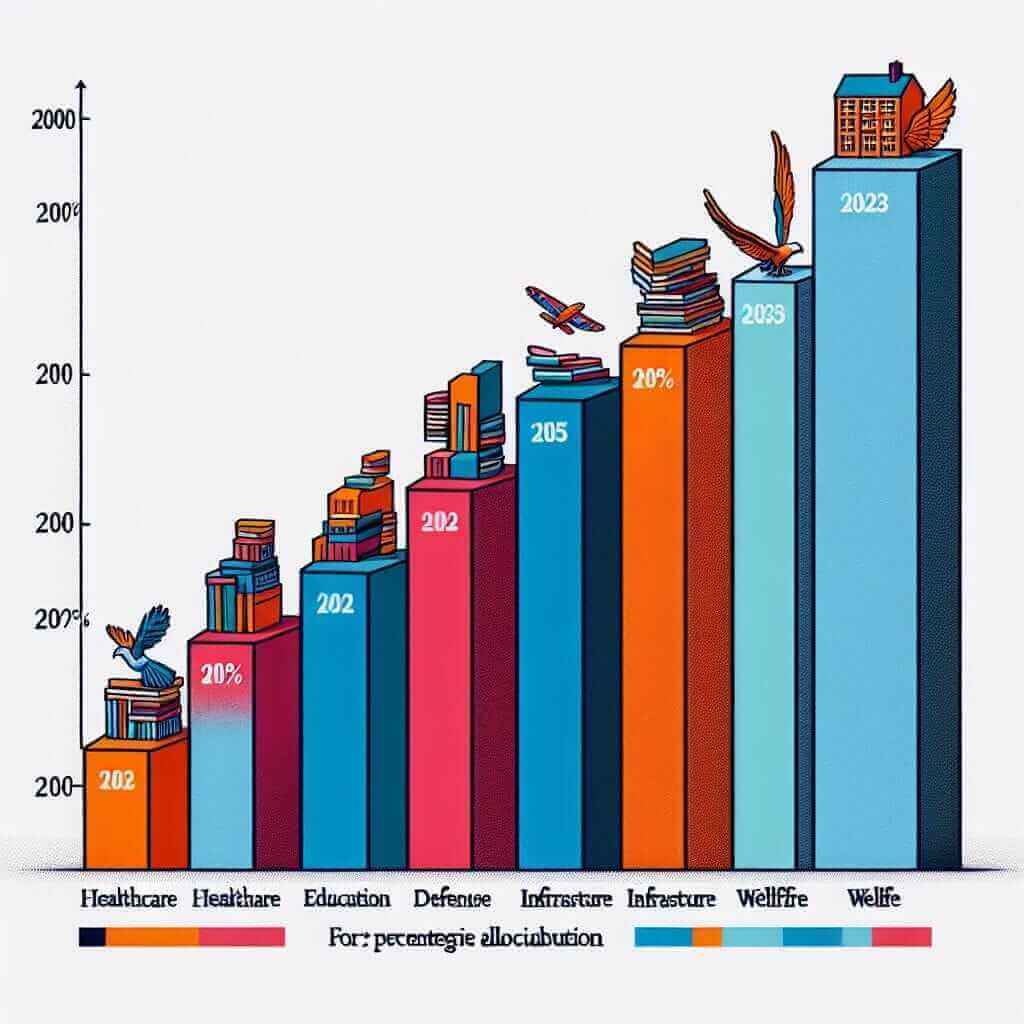When it comes to excelling in the IELTS Writing Task 1, the ability to interpret and accurately describe graphs, charts, and tables is essential. A common topic that you may encounter is the allocation of the annual budget across different sectors over a period extending from 2000 to 2023. This type of question tests your skills in summarizing the information, making comparisons, and indicating trends effectively.
A. Creating a Sample IELTS Task 1 Prompt
Based on the topic of “Annual Budget Allocation in Different Sectors (2000-2023),” let’s generate a sample IELTS Writing Task 1 prompt:
Sample Task 1 Prompt:
The chart below shows the percentage of the annual budget allocated to five different sectors from 2000 to 2023.
(NOTE: Since there is no actual chart provided here, you can visualize a sample bar chart with budget allocations for categories such as Healthcare, Education, Defence, Infrastructure, and Welfare.)

B. Sample Writing Task 1: Data Analysis and Reporting
1. Understanding the Task
Begin by closely analyzing the given data. Make note of the following:
- Different sectors: Healthcare, Education, Defence, Infrastructure, and Welfare.
- The timeline from 2000 to 2023.
- The percentage fluctuations in each sector over the given period.
2. Organizing Your Response
A well-structured response should include:
- Introduction: Paraphrase the task statement.
- Overview: Summarize the main trends or significant information.
- Detailed Comparisons: Highlight key changes and comparisons between sectors over the specified period.
3. Sample Response
Introduction:
The bar chart illustrates the percentage distribution of the annual budget across five sectors, namely Healthcare, Education, Defence, Infrastructure, and Welfare, for the years 2000 to 2023.
Overview:
Overall, the majority of the budget was allocated to Healthcare and Education throughout the given period. There is a noticeable increase in the allocation for Healthcare, while Defence saw a significant decline. Infrastructure and Welfare allocations fluctuated but maintained a relatively stable percentage.
Detailed Comparisons:
In 2000, Healthcare and Education received the highest portions of the budget, at 25% and 20%, respectively. By 2023, the allocation for Healthcare had risen sharply to 35%, reflecting an increased emphasis on medical services. Education saw a marginal increase to 22%.
Conversely, Defence started with 15% of the budget in 2000 but experienced a steady decline to 8% by 2023, indicating a possible shift in government priorities away from military spending.
Infrastructure and Welfare percentages show more variability: Infrastructure started at 18% in 2000, dipped to 15% in 2010, but rebounded slightly to 17% by 2023. Welfare allocation initially stood at 22%, fluctuated down to 19% in 2010, and hovered around 20% towards the end of the period.
Word Count: 185 words
4. Key Points to Remember When Writing
- Use a variety of sentence structures (simple, compound, complex) to enhance the readability and interest of your writing.
- Employ comparative language effectively (e.g., “whereas,” “while,” “compared to,” “by contrast”).
- Summarize significant trends in the overview without specific data details; leave the detailed comparisons for the body paragraphs.
- Ensure your writing is cohesive and logically structured.
5. Advanced Vocabulary and Phrases
Here are some sophisticated terms and phrases you should master (with explanations):
- Expenditure (noun /ɪkˈspɛndɪtʃər/): The act of spending funds.
- Example: “The expenditure on healthcare rose significantly.”
- Allocate (verb /ˈæləˌkeɪt/): To distribute or assign resources for a specific purpose.
- Example: “A substantial portion of the budget was allocated to education.”
- Fluctuate (verb /ˈflʌktʃʊˌeɪt/): To vary or change irregularly.
- Example: “The budget allocation for welfare fluctuated over the years.”
- Marginal (adjective /ˈmɑrdʒɪnl/): Very slight or small.
- Example: “There was a marginal increase in the education budget.”
- Rebound (verb /rɪˈbaʊnd/): To recover from a setback.
- Example: “The infrastructure budget saw a rebound after a period of decline.”
- Emphasis (noun /ˈɛmfəsɪs/): Special importance or significance.
- Example: “There was a strong emphasis on increasing healthcare funding.”
- Decline (noun /ˈdɪklaɪn/): A decrease in power, quantity, or quality.
- Example: “The defence budget faced a continuous decline.”
Conclusion
In summary, when tackling IELTS Writing Task 1 questions related to budget allocation across various sectors, focus on accurately interpreting the data, summarizing key trends, and making clear, detailed comparisons. By mastering specific vocabulary and maintaining a structured approach, you can aim for a Band 7+ score. Remember to practice regularly using real data and sample prompts to enhance your skills.